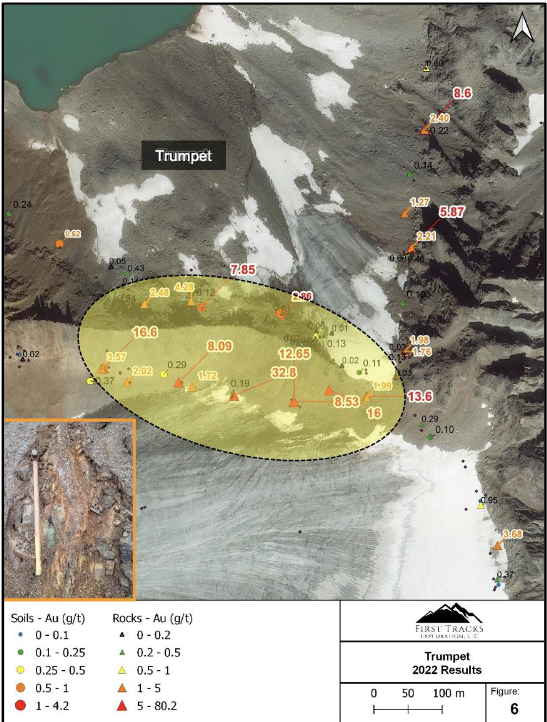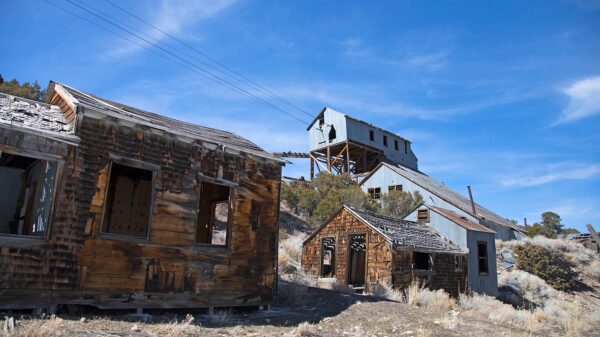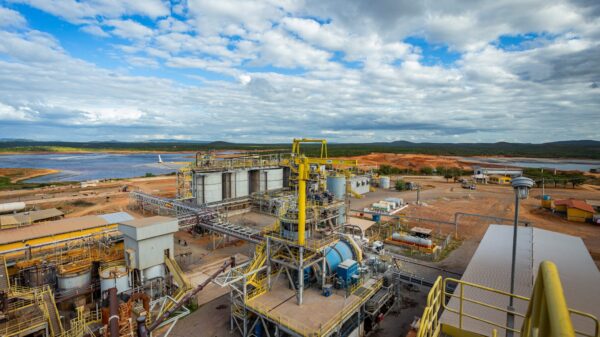Nova Minerals Limited (ASX: NVA) (OTC: NVAAF) (FSE: QM3) started its targeted drill campaign at its Estelle Gold Project property in Alaska with additional rigs arriving in the next few weeks.
The company said on Tuesday that it will drill approximately, 15,000 meters using an average of three diamond rigs focusing on increasing the resource’s drill density, and extensional drilling to grow the global gold resource.
The company’s drilling on the RPM ridge line is to infill and expand the at-surface high-grade resource around the deposits at both RPM North and RPM South. Previously, Nova had discovered high grade intercepts at RPM south including:
• RPM 0051: 400 meters at 3.5 g/t Au,
- including 287 meters at 4.8 g/t Au,
- including 132 meters at 10.1 g/t Au, and
- including 86 meters at 14.1 g/t Au
• RPM 0152: 258 meters at 5.1 g/t Au,
- including 161 meters at 8.1 g/t Au,
- including 117 meters at 11.1 g/t Au, and
- including 45 meters at 25.3 g/t Au
• RPM 0083: 260 meters at 3.6 g/t Au,
- including 140 meters at 6.5 g/t Au,
- including 87 meters at 10.1 g/t Au, and
- including 56 meters at 15.0 g/t Au
After creating new platforms for drilling in the valley, the next focus will be on exploring the 600-meter high-priority mineralized zone that connects RPM North to RPM South. This area has shown continuous mineralization and also revealed another significant mineralized intrusive in the lower sections of drill holes RPM 037 and RPM 025.
Notable findings from these holes include:
• RPM 037: 103 meters at 1.0 g/t Au, including 30 meters at 1.9 g/t Au, and 21 meters at 2.5 g/t Au from 325 meters.
• RPM 037: 79 meters at 1.0 g/t Au from 471 meters, including 30 meters at 2.0 g/t Au from 501 meters.
• RPM 025: 76 meters at 1.2 g/t Au from 440 meters, including 43 meters at 1.5 g/t Au from 474 meters.

Intrusive hornfels contact zone observed are similar to those in the RPM property. Image via Nova Minerals.
Read more: Galiano Gold awards mining contract for Asanko Gold Mine in Ghana
Read more: New Found Gold reports more high-grade drill results in Eastern Canada
Drill program objective to explore and define mineralization
New drill platforms are being built in the Train area. This year, the main objective of the drilling program will be to explore and define the mineralization similar to that found in the RPM area. This type of mineralization has been observed in both the Train and Trumpet areas, as well as along a 1.5-kilometer stretch between the two prospects. The ultimate goal is to identify a third significant resource area and establish a fifth major gold deposit on the Estelle Gold Project by the end of 2023.
Based on geological observations and samples collected from the Train and Trumpet prospects, high-grade rock chip samples were obtained including:
• Train – 80.2 g/t Au, 30.4 g/t Au, 24.5 g/t Au, 21.6 g/t Au and 17.9 g/t Au
• Trumpet – 32.8 g/t Au, 16.6 g/t Au, 16.0 g/t Au, 13.6 g/t Au and 12.7 g/t Au
• 1.5km link between Train and Trumpet – 30.4 g/t Au and 21.6 g/t Au
Shares of Nova Minerals dipped 28.8 per cent to $0.378 on the OTC markets on Tuesday.
Read more: New Found Gold reports more high-grade drill results in Eastern Canada
Read more: Endeavour Mining sells Burkina Faso mines for USD$300M
Alaska has a lengthy history of gold mining
Mining plays a significant role in Alaska’s economy, and gold is one of the primary minerals sought by miners. It’s been that way for a long time. The state has a rich history of gold mining, with large-scale operations as well as smaller-scale placer mining activities dotting the land. The mineral-rich regions of Alaska, such as the Klondike, Nome and the Fairbanks area, have attracted miners from around the world seeking to extract the valuable metal.
The cold weather plays a factor in production for Kinross Gold Corp‘s (TSX: K) (NYSE: KGC) Fort Knox gold mine. There’s a decline in production every year as the cold weather affects the heap leach extraction process for gold, resulting in lower recoveries. As the weather improves, however, so do the gold recoveries leading to gold production increases.
According a May report from Kinross, Fort Knox yielded 65,404 ounces of gold in the Q1, 2023, which represents a 33 per cent decrease compared to the previous three-month period when 87,061 ounces were produced.
The number of indigenous nations from the Kuskokwim River region opposing the federal permits for the Donlin Gold project, jointly owned by Barrick Gold (TSX: ABX) (NYSE: GOLD) and NovaGold Resources (TSX: NG) (NYSE: AG), has increased from three to six. They argue that the permitting process was flawed and that the consultation with indigenous nations was insufficient. These tribes are now seeking intervention from the court to compel the federal government to conduct a more thorough examination of the project.
In early June, the Chevak Native Village joined other tribes from the Yukon-Kuskokwim area in filing a federal lawsuit against the proposed Donlin Gold mine. They are united in their efforts to challenge the project and address concerns regarding its potential impacts on the region.
The Chevak Native Village and other communities are asking for closer examination of the Donlin project to safeguard the Yukon-Kuskokwim Delta ecosystem and the natural resources vital for their traditional way of life and survival.
.
Follow Joseph Morton on Twitter
joseph@mugglehead.com














